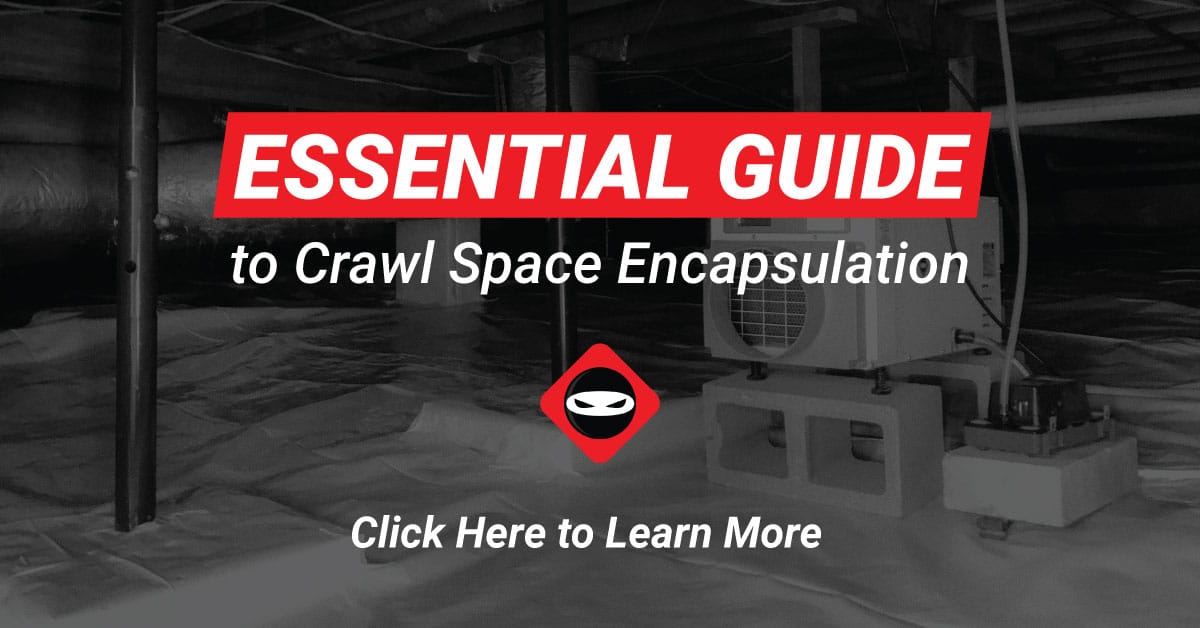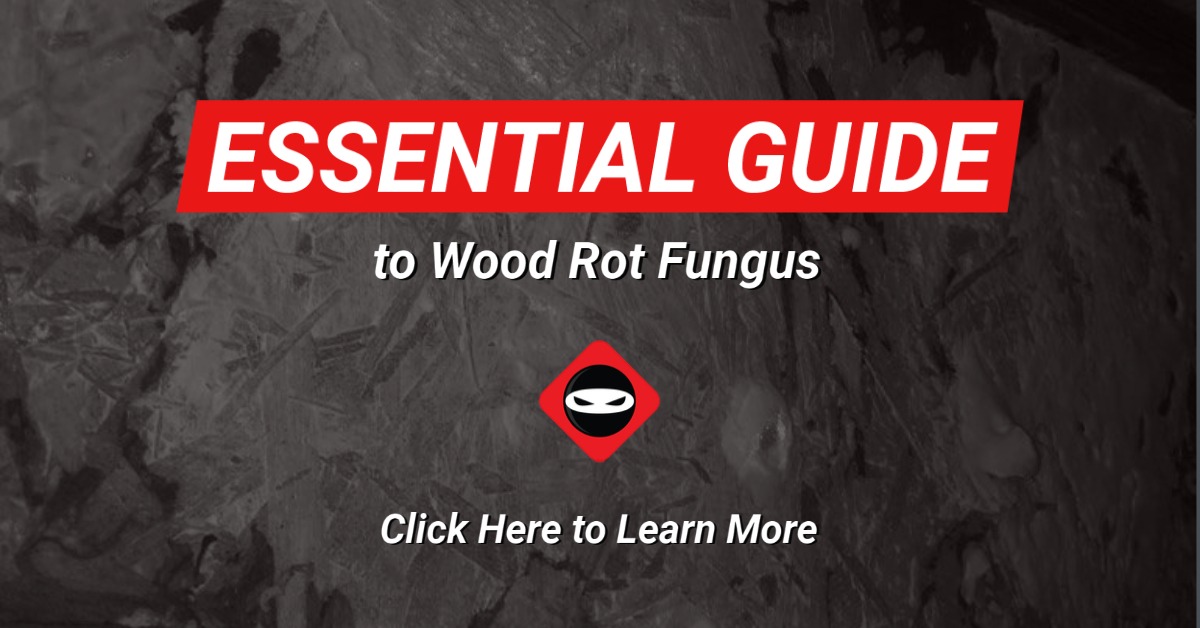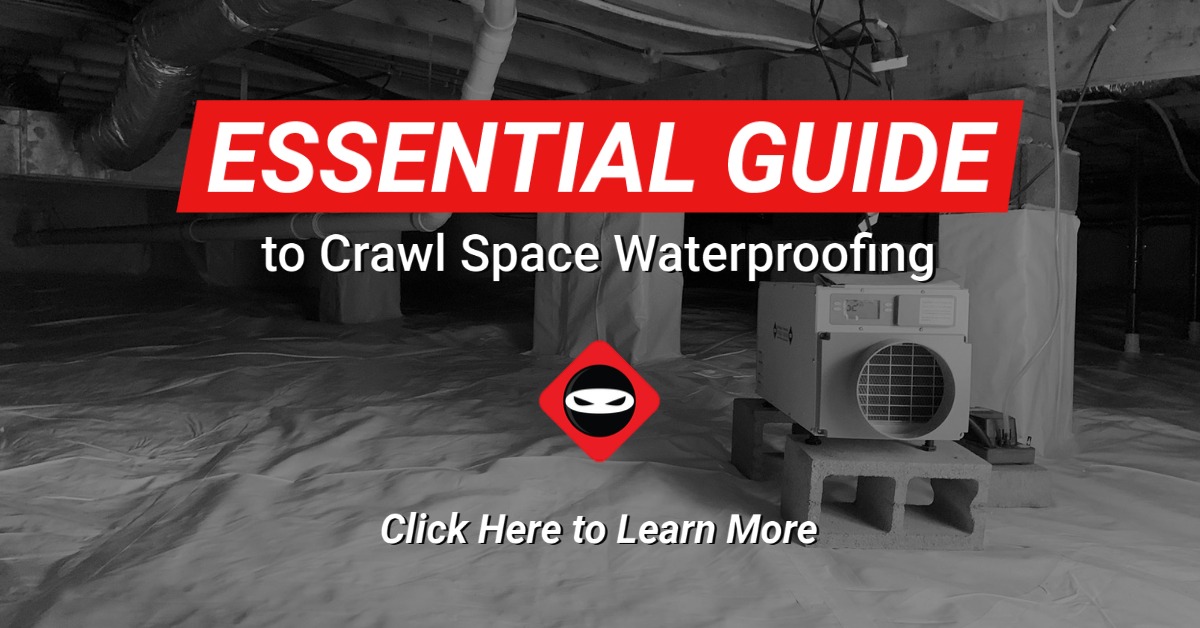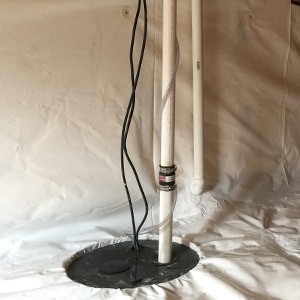Bad crawl space repairs are common in our industry because there really is no standard when it comes to fixing crawl spaces. When considering crawl space repair make sure you understand that you can make things worse if you do repairs out of order or incorrectly.
DIY crawl space repair is a great way to save money when it is done correctly.
For example, using a vapor barrier that eventually could smell like cat pee should be avoided. The cost to repair a crawl space can be minimal when compared to the cost to correct bad crawl space repairs.
Wet Crawl Spaces are Common
A wet crawl space is common in the summer due to high humidity and dew point. An unusually hot summer can make a vented crawl space even worse than usual because the air conditioner is having to work harder and longer to maintain the proper temperature which may increase condensation.
When the dew point is reached in a crawl space that’s when condensation occurs. Condensation can create mold growth and even damage insulation, flooring, joists and sub-floors.
Vented Crawl Spaces Can Cause Moisture Problems
An open or vented crawl space allows humidity to freely travel in which means the crawl space is the same humidity level inside as the relative humidity outside. Because of the HVAC air ducts, the humidity can get even worse inside the crawl space.
When that humid air hits the cold air ducts condensation occurs and will add to the already present humidity. This can cause some crawl spaces to reach more than 90% relative humidity. High humidity soaks into the fiberglass, joists, sub-floor and other porous materials and may lead to mold and wood rot fungus that can damage the home and affect your health.
Ready to find out more?
Drop us a line today for a quote!
Click Here10 Terrible Crawl Space Repair Examples
1. Adding fiberglass to a humid or wet crawl space:
One bad crawl space repair we see very often is replacing wet fiberglass in a wet crawl space. Fiberglass or Batt insulation is just that, glass fibers that are woven together and looks similar to wool. In a crawl space, fiberglass insulation is normally placed between joists against the sub-floor and also shoved into the rim joists. Fiberglass can be a home for rodents and pests and will absorb water.
The Risks of Using Fiberglass Insulation in Wet Conditions
Fiberglass will trap water from humidity or a plumbing leak against the floor and joists. In extreme cases this trapped water can even cause hardwood floors to cup or buckle. Wet wood will eventually grow mold. Fiberglass can also become so heavy from the absorbed water that it falls out of place and your home loses its efficiency.
2. Improperly installing a sump pump:
Sump Pump ComplicationsWe recently addressed a standing water problem in a crawl space where they installed a sump pump improperly. The basin did not have weep holes to allow the ground water to enter. The water had to reach the ground’s surface in order to enter the basin.
Also, the sump pump was too big for the basin and kept tipping over so it would not turn on without the homeowner having to constantly intervene. The discharge hose did not have a check valve installed so when the water was pumped out it would back flow into the basin after the pump shut off and this caused the pump to run more than necessary.
Trenching and Water Alarm Benefits:
And lastly, the crawl space had standing water throughout and that water had no clear path to reach the basin and sump pump. Properly trenching the perimeter of the crawl space would have corrected that issue and given the standing water a path to the sump pump. It’s a good idea to install a water alarm to alert you immediately of any standing water or flooding that could occur in your crawl space.
3. Encapsulating without a dehumidifier:
Crawl space encapsulation seems to be the preferred method for controlling moisture. Many homeowners will perform crawl space encapsulation but then choose not to install a dehumidifier.
Common Mistakes in Sizing and Draining Crawl Space Dehumidifiers
Many times the crawl space dehumidifier may be sized incorrectly or drained improperly. Draining the dehumidifier directly out of the crawl space or into a sump pump basin is a great option that seems to produce less problems. Draining the dehumidifier under the vapor barrier can increase the humidity because moisture can eventually evaporate from under the plastic.
Monitoring and Maintenance: The Key to Effective Dehumidification in Crawl Spaces
Another option is to install a remote humidity reader so you can keep close tabs on the relative humidity of your crawl space and make sure the dehumidifier is working properly. Make sure you check the dehumidifier every few months to ensure filters are clean and all parts are working properly. The dehumidifier is the heart of a healthy crawl space encapsulation system.
4. Crawl space encapsulation without ventilation:
Radon and soil gases can build up in a closed or improperly encapsulated crawl space. Soil gases can be from contaminated water or soil in your area. The Environmental Protection Agency has more information about “Soil Vapor” on their website epa.gov.
Radon is a soil gas most people are familiar with and it is caused from decayed uranium found in the soil under your home. An open or vented crawl space allows soil gases to exit the home regularly but when that crawl space is closed or encapsulated, the gases or vapor has nowhere to go except up into your living space.
Radon Risks in Encapsulated Crawl Spaces
Properly installing an active ventilation system or sub-membrane radon mitigation system is recommended by the EPA in all closed crawl spaces. This will add other benefits to the properly insulated crawl space and make your home even more efficient.
5. Using gravel to cover the floor versus a vapor barrier:
We sometimes get asked if we can install gravel on the crawl space floor to stop moisture from evaporating from the soil. The answer is “yes” we can install the gravel but “no” it won’t stop moisture from evaporating. This is another common bad crawls pace repair we see homeowners do.
Gravel on the crawl space floor does little to help the crawl space at all and makes it hard to work in. It can also puncture the vapor barrier which will allow humidity to escape more rapidly into the crawl space and make the dehumidifier run more which will increase your utility bill.
Gravel can allow water to channel under the vapor barrier but it is not the best solution available. There are better alternatives to gravel if you want to channel water under the vapor barrier.
6. Spray foaming the entire sub-floor:
Spray foam insulation is great when used properly. We utilize spray foam on almost every job to air seal the crawl space. When spray foam is used properly, the Department of Energy says it may save up to 19% on your utility bills.
Applying spray foam to the entire sub-floor is a great idea if you never have a water leak from above. If a pipe ever starts to leak, that water can become trapped just like it would with fiberglass insulation. Trapped water leads to all sorts of mold and wood decay fungus damage.
Ready to find out more?
Drop us a line today for a quote!
Click Here7. Installing a vapor barrier to the joists/sub-floor:
A horrible crawl space repair is attaching vapor barrier to the sub-floor. We have ripped out many thousands of square feet of crawl space plastic that was installed (stapled) to the joists in a crawl space or unfinished basement. Moisture gets trapped between the plastic, insulation and sub-floor and has no way to escape.
Installing a vapor barrier properly on the ground and possibly walls of a crawl space should be sufficient to control moisture with the addition of a properly sized and installed crawl space dehumidifier.
8. Fixing a sagging floor before addressing the mold:
Sometimes moisture, mold or wood destroying fungus can be the cause of floor issues and foundation problems. If your home has sagging floors you should consider having the wood treated for mold and apply a mold preventative as well as address the moisture problem before fixing the floors or foundation.
It is much more difficult and costly to address the mold and water issue after because many times new wood is used and pressed against the moldy damaged wood. This sandwiches the mold between new and old wood. The mold will attack the new wood and given enough time can damage it to the point of needing repair as well.
9. Adding more foundation vents or power vents:
The Southern United States, especially Tennessee, is very humid so adding more vents or fans to a crawl space in order to draw outside air in may do more harm than good.
Their should be measures in place to control humidity and bringing outside air into a crawl space with a foundation fan is not controlled. An open or vented crawl space is at the same humidity level as the air outside so if you have a few weeks or months at high humidity outside, the same is true for your crawl space.
10. Insulating the walls of an open/vented crawl space:
If you choose to leave your crawl space vented or open then one of the best ways to insulate it is with fiberglass installed between the joists and against the sub-floor. Applying foam board insulation to an open crawl space does not help in keeping the cold or heat from entering the crawl space because the vents allow the outside temperature to freely enter.
This can make the floors colder in the winter and may cause a flood if the pipes are not properly insulated. Only insulate the walls if you decide to close the crawl space. I know this totally contradicts #1 above but if you are going to keep your crawl space open, it must be insulated and in an open crawl space fiberglass is the best alternative.
Just make sure you inspect the humidity of your crawl space on a regular basis and look for falling fiberglass insulation. If you appear to have strips of fiberglass dangling down like stalactites, this is an indication of a humidity or other moisture problem.
Bonus Bad Crawl Space Repair Tip:
Another bad crawl space repair we see is to upgrade your HVAC system but keeping the old leaky ducts and nasty inefficient duct insulation. If you have a ten plus year old home, the insulation R value of your air ducts may need to be upgraded or the ducts themselves may need to be replaced or air sealed for maximum efficiency.
Consider this expense when upgrading your HVAC system because improperly insulated or poorly sealed air ducts are more likely to condensate with a more powerful HVAC system. Some estimate that up to 25% of your conditioned air can be lost in the crawl space due to improper sealing and inadequate insulation of the air ducts
Contact Crawl Space Ninja for Basement Waterproofing and Encapsulation
Please contact us to schedule your assessment to fix your crawl space, basement issue.
Do you need help with mold removal, crawl space encapsulation, crawl space insulation, vapor barrier, waterproofing, foundation repair, basement waterproofing, or controlling humidity in your crawl space?
If you live in Georgia, Delaware, North Carolina, South Carolina, Tennessee, or Kentucky, Crawl Space Ninja can help!
Also, let us know in the comments below if you have an idea for a new blog topic.
DIY Crawl Space Repair
Perhaps you’d like to tackle your own crawl space repair. Visit our DIY Store.
Join Crawl Space Ninja as an Owner
Learn about Crawl Space Ninja Franchise opportunities.





